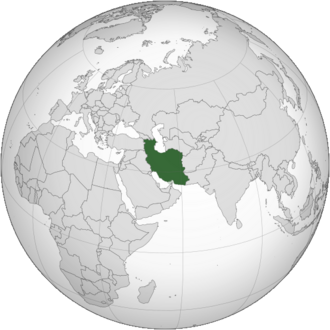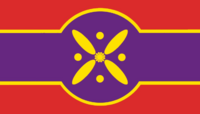Iran (Geopolity): Difference between revisions
No edit summary |
mNo edit summary |
||
| Line 93: | Line 93: | ||
Iran is one of the world's oldest civilizations, beginning with the [[wikipedia:Elam|Elamites]] in the fourth millennium BC. It was first unified by the [[wikipedia:Medes|Medes]] in the seventh century BC and reached its territorial height in the sixth century BC, when [[wikipedia:Cyrus_the_Great|Cyrus the Great]] founded the [[wikipedia:Achaemenid_Empire|Achaemenid Empire]], one of the largest empires in antiquity. [[wikipedia:Alexander_the_Great|Alexander the Great]] conquered the empire in the fourth century BC, and it was subsequently divided into several Hellenistic states. An Iranian rebellion established the [[wikipedia:Parthian_Empire|Parthian Empire]] in the third century BC, which was succeeded in the third century AD by the [[wikipedia:Sasanian_Empire|Sasanian Empire]]. | Iran is one of the world's oldest civilizations, beginning with the [[wikipedia:Elam|Elamites]] in the fourth millennium BC. It was first unified by the [[wikipedia:Medes|Medes]] in the seventh century BC and reached its territorial height in the sixth century BC, when [[wikipedia:Cyrus_the_Great|Cyrus the Great]] founded the [[wikipedia:Achaemenid_Empire|Achaemenid Empire]], one of the largest empires in antiquity. [[wikipedia:Alexander_the_Great|Alexander the Great]] conquered the empire in the fourth century BC, and it was subsequently divided into several Hellenistic states. An Iranian rebellion established the [[wikipedia:Parthian_Empire|Parthian Empire]] in the third century BC, which was succeeded in the third century AD by the [[wikipedia:Sasanian_Empire|Sasanian Empire]]. | ||
After resistance to Arab Muslim attempts at a conquest of Iran, culminating in the victorious [[wikipedia:Battle_of_Nahavand|Battle of Nahavand]], the Sasanians ruled the country until the [[wikipedia:Seljuks|Seljuk]] and the [[wikipedia:Ilkhanate|Mongol]] conquests of the 11th to 14th centuries. In the 15th century, the native [[wikipedia:Sasanian_dynasty|House of Sasan]] re-established a neo-Sasanian Iran with [[wikipedia:Zoroastrianism|Zoroastrianism]] as the official religion, marking the beginning of modern Iranian history. The established Sasanians proceeded on an expansive, nearly four century-long process of [[wikipedia:Persianization|Persianization]], primarily through a lessening of Turkic characteristics in groups such as the Azeris, Qashqai peoples, and Khorasani Turks and re-establishing Zoroastrianism as the state religion | After resistance to Arab Muslim attempts at a conquest of Iran, culminating in the victorious [[wikipedia:Battle_of_Nahavand|Battle of Nahavand]], the Sasanians ruled the country until the [[wikipedia:Seljuks|Seljuk]] and the [[wikipedia:Ilkhanate|Mongol]] conquests of the 11th to 14th centuries. In the 15th century, the native [[wikipedia:Sasanian_dynasty|House of Sasan]] re-established a neo-Sasanian Iran with [[wikipedia:Zoroastrianism|Zoroastrianism]] as the official religion, marking the beginning of modern Iranian history. The established Sasanians proceeded on an expansive, nearly four century-long process of [[wikipedia:Persianization|Persianization]], primarily through a lessening of Turkic characteristics in groups such as the Azeris, Qashqai peoples, and Khorasani Turks and re-establishing Zoroastrianism as the state religion. | ||
Under Khosraw XI in the 18th century, Iran was a leading world power, though by the 19th century, it had lost significant influence through a series of conflicts with the Russian Empire. Under the liberal-minded Shahanshahs Peroz VIII and his son Vistahm V, the early and mid-20th century saw a significant shift towards fusing Western ideals such as economic liberalization, the abolition of the traditional [[wikipedia:Wuzurgan|wuzurgan]] nobility and powers of the priestly elite, a modernized military, the encouragement of industrialization, urbanization, the loosening of strict religious laws, a great expansion of civil liberties, the establishment of the Imperial Diet, the nationalization of the burgeoning fossil fuel industry, and a centralized, efficient bureaucracy, with traditional ideals such as the continued maintenance of Zoroastrianism as the state religion (albeit with a more distinct seperation from the state). | Under Khosraw XI in the 18th century, Iran was a leading world power, though by the 19th century, it had lost significant influence through a series of conflicts with the Russian Empire. Under the liberal-minded Shahanshahs Peroz VIII and his son Vistahm V, the early and mid-20th century saw a significant shift towards fusing Western ideals such as economic liberalization, the abolition of the traditional [[wikipedia:Wuzurgan|wuzurgan]] nobility and powers of the priestly elite, a modernized military, the encouragement of industrialization, urbanization, the loosening of strict religious laws, a great expansion of civil liberties, the establishment of the Imperial Diet, the nationalization of the burgeoning fossil fuel industry, and a centralized, efficient bureaucracy, with traditional ideals such as the continued maintenance of Zoroastrianism as the state religion (albeit with a more distinct seperation from the state). | ||
In 1953, a series of | In 1953, a series of | ||
Revision as of 22:19, 24 April 2024
Note that this Iran is not the same as the Islamic Republic of Iran. This page is a factbook for the Geopolity RP server. Please do not edit this page.
Empire of Iran 𐬌𐬭𐬀𐬥𐬱𐬀𐬵𐬭 (Farsi) Iranšahr | |
|---|---|
| Motto: "𐬀𐬥𐬛𐬀𐬱 𐬥𐬀𐬐𐬆, 𐬔𐬎𐬟𐬙𐬀𐬭 𐬥𐬀𐬐𐬆, 𐬐𐬆𐬭𐬛𐬀𐬭 𐬥𐬀𐬐𐬆" (Farsi) (Andaš Nake, Guftar Nake, Kerdar Nake) "Good Thoughts, Good Words, Good Deeds" | |
| Anthem: Long Live our Shahanshah | |
 Iran on the globe | |
| Capital and largest city | Rhages |
| Official languages | Farsi in the Avestan alphabet |
| Recognized national languages | Avestan (Liturgical) |
| Recognized regional languages | Azeri, Kurdish, Luri, Gilaki, Mazanderani, Armenian, Turkmen, Arabic, Balochi, Pashto, Tajik, Qashqai, Laki, Suret, Khorasani Turkic, Tati, Talysh |
| Ethnic groups | |
| Religion |
|
| Demonym(s) | Iranian |
| Government | Unitary Parliamentary Constitutional Monarchy |
• Shahanshah (Shahbanu if female) | His Majesty Ardashir VI |
• Wuzurg Framadar | Her Excellency Behdis Gaanjia |
| Legislature | The Imperial Diet |
| The Darbar | |
| The Mehestan | |
| Establishment History | |
| Area | |
• Total | 1,764,538 km2 (681,292 sq mi) |
• Water (%) | 1.1% |
| Population | |
• 2024 estimate | 105,400,000 |
• 2020 census | 103,674,582 |
• Density | 59.7/km2 (154.6/sq mi) |
| GDP (PPP) | 2024 estimate |
• Total | $2.73 trillion |
• Per capita | $25,888 |
| GDP (nominal) | 2024 estimate |
• Total | $852.7 billion |
• Per capita | $8,090 |
| Gini | 33.7 medium |
| HDI | 0.881 very high |
| Currency | Iranian Daric (Ð) |
| Time zone | UTC+3:30 (IRST) [No DST] |
| Date format | dd-mm-yyyy (Z.E.R. and CE) |
| Driving side | right |
| Calling code | +98 |
| ISO 3166 code | IR |
| Internet TLD | .ir |
Iran, historically known as Persia by Western nations, and officially the Empire of Iran, is a country in West Asia. It is bordered by the Ottoman Empire to the west, Russia to the northwest, the Central Asian Union to the northeast, the Caspian Sea to the north, and the Iranian Gulf to the south, near Arabia. With over 100 million people in an area of 1.76 million sq km (about 680 thousand sq mi), Iran ranks as the 3rd largest nation in the Middle East by both population (behind Egypt and the Ottoman Empire) and largest by area (behind Egypt and Arabia). The nation's capital and most populous city is Rhages, with around 8 million people. Other major cities include Sanabad, Spahan, Baku, Tawres, Fars, Huzaye, Kom, and Hormirzad.
Iran is one of the world's oldest civilizations, beginning with the Elamites in the fourth millennium BC. It was first unified by the Medes in the seventh century BC and reached its territorial height in the sixth century BC, when Cyrus the Great founded the Achaemenid Empire, one of the largest empires in antiquity. Alexander the Great conquered the empire in the fourth century BC, and it was subsequently divided into several Hellenistic states. An Iranian rebellion established the Parthian Empire in the third century BC, which was succeeded in the third century AD by the Sasanian Empire.
After resistance to Arab Muslim attempts at a conquest of Iran, culminating in the victorious Battle of Nahavand, the Sasanians ruled the country until the Seljuk and the Mongol conquests of the 11th to 14th centuries. In the 15th century, the native House of Sasan re-established a neo-Sasanian Iran with Zoroastrianism as the official religion, marking the beginning of modern Iranian history. The established Sasanians proceeded on an expansive, nearly four century-long process of Persianization, primarily through a lessening of Turkic characteristics in groups such as the Azeris, Qashqai peoples, and Khorasani Turks and re-establishing Zoroastrianism as the state religion.
Under Khosraw XI in the 18th century, Iran was a leading world power, though by the 19th century, it had lost significant influence through a series of conflicts with the Russian Empire. Under the liberal-minded Shahanshahs Peroz VIII and his son Vistahm V, the early and mid-20th century saw a significant shift towards fusing Western ideals such as economic liberalization, the abolition of the traditional wuzurgan nobility and powers of the priestly elite, a modernized military, the encouragement of industrialization, urbanization, the loosening of strict religious laws, a great expansion of civil liberties, the establishment of the Imperial Diet, the nationalization of the burgeoning fossil fuel industry, and a centralized, efficient bureaucracy, with traditional ideals such as the continued maintenance of Zoroastrianism as the state religion (albeit with a more distinct seperation from the state).
In 1953, a series of

